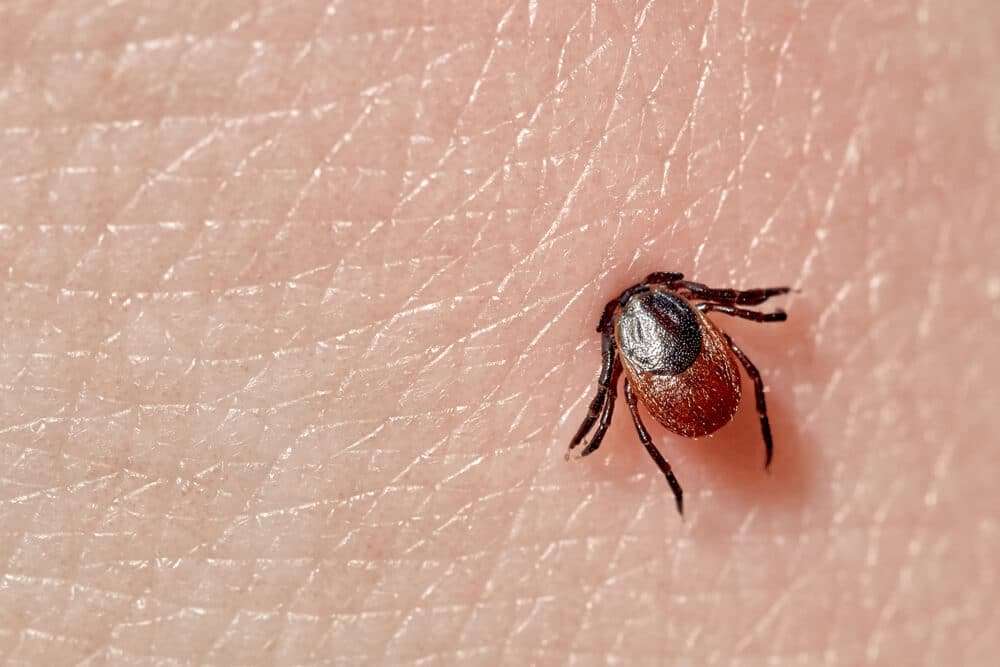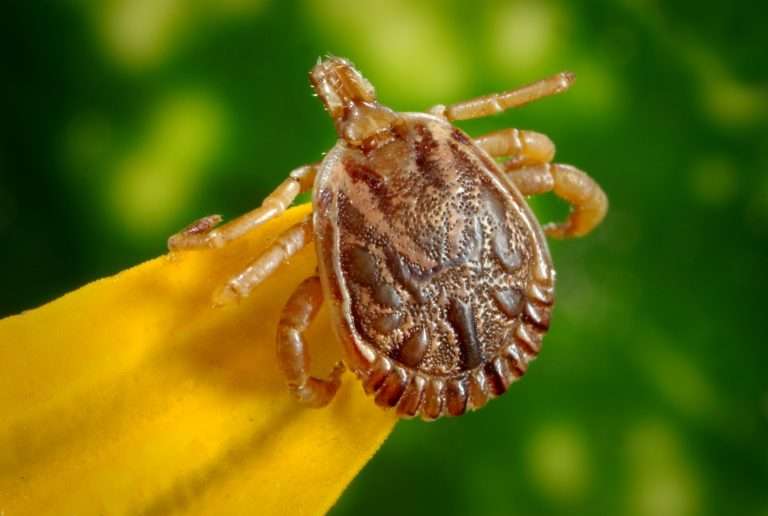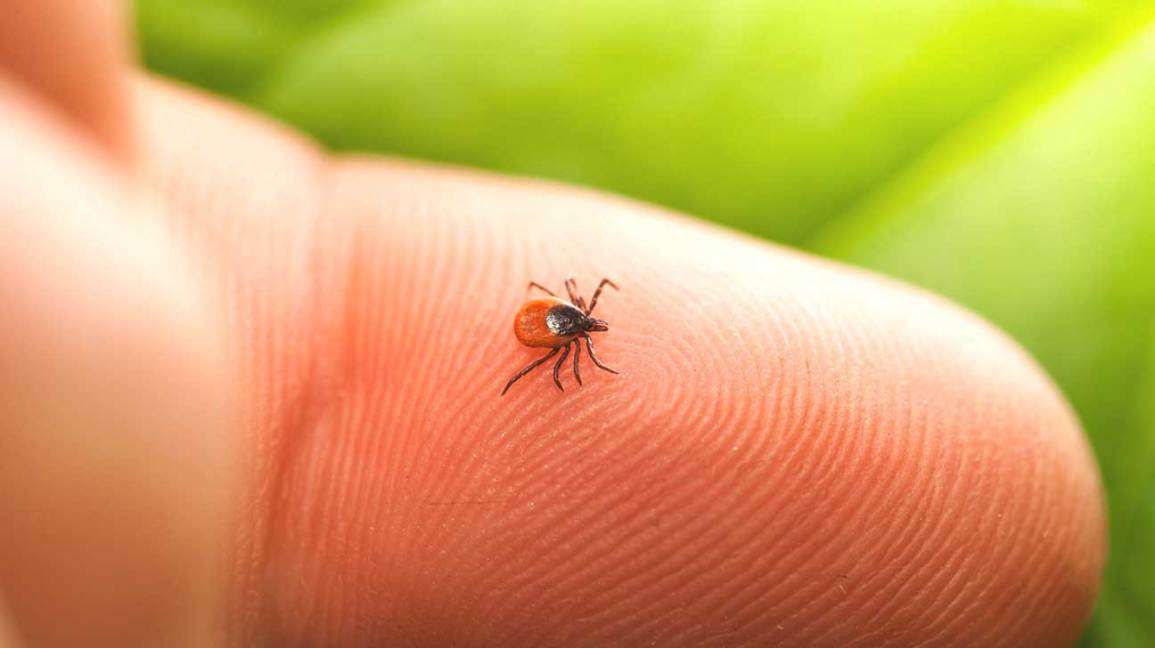How To Remove A Tick Safely
Although the risk of Lyme disease is very low in Alberta, there are other tick-borne diseases that can be transmitted by ticks.
It is important to properly remove a tick as soon as possible. Removing a tick 24 to 36 hours after a tick bite usually prevents Lyme disease from developing.
If a tick is attached to your skin, you can safely remove it.
- Using tweezers, gently grasp its head and mouth parts as close to your skin as possible to avoid leaving mouthparts in the skin or crushing the tick.
- Without squeezing the tick, slowly pull the tick straight up off the skin do not jerk or twist it.
- Do not apply matches, cigarettes, dish soap, petroleum jelly or any other substance to the tick. This will not encourage the tick to detach and may cause it to release infectious blood back into the wound.
- Once the tick has been removed, clean the bite area with soap and water and disinfect the area with an antiseptic. Wash hands with soap and water.
- Consider submitting a photograph of the tick to the Submit-a-Tick program.
- If you do not plan to submit a photograph of the tick to the Submit-a-Tick program, you can kill the tick by placing it in a freezer for 24 hours, or putting it in rubbing alcohol. Once killed, dispose of it by flushing it down the toilet, or placing it in the garbage. Avoid crushing a tick with your fingers as they may be filled with blood and other infectious material.
How Do You Prevent Tick Bites
While there is no human vaccine against Lyme disease, the best form of protection from Lyme disease is to prevent tick bites.
Before going outdoors, be sure to spray yourself and clothing with a bug repellent that contains DEET. You can also find U.S Environmental Protection Agency approved insect repellent to suit your needs. If youre an avid camper or hiker, you can treat your clothing and gear with products that contain 0.5% permethrin that will last for several washings to ensure your protection.
Be sure to examine yourself thoroughly for ticks around your hairline, ears, armpits, groin, belly button and the back of your legs for ticks once you return indoors. The CDC suggests showering to help wash off potentially unattached ticks that you may not have seen. Examine your clothes and if possible, put them in the dryer for at least ten minutes to kill any ticks that may have made their way indoors.
Ticks often migrate through animals, meaning your pet could be a carrier or ticks into your home. Aside from asking your vet about a suitable tick prevention product, be sure to check your pet around the ears, eyelids, tail, collar and under their legs for ticks.
Not All Ticks Are The Same
Different species of ticks carry different types of bacteria, viruses and protozoa. However, new tick-borne infections are emerging as tick habitats change over time. For example, the deer tick is now reported in 50% of US counties by the CDC. The Lone Star tick is also on the move and expanding into the Northeastern states.TICKNOLOGY has one comprehensive tick testing panel for all ticks that threaten US residents.
Don’t Miss: Ways To Test For Lyme Disease
What Do The Results Mean
The Centers for Disease Control and Prevention recommends a two-test process of your sample:
- If your first test result is negative for Lyme disease, you don’t need any more testing.
- If your first result is positive for Lyme disease, your blood will get a second test.
- If both results are positive for Lyme disease and you also have symptoms of infection, you probably have Lyme disease.
Positive results don’t always mean a Lyme disease diagnosis. In some cases, you can have a positive result but not have an infection. Positive results may also mean you have an autoimmune disease, such as lupus or rheumatoid arthritis.
If your lumbar puncture results are positive, it may mean you have Lyme disease, but you might need more tests to confirm a diagnosis.
If your health care provider thinks you have Lyme disease, he or she will prescribe antibiotic treatment. Most people who are treated with antibiotics in the early stage of disease will make a complete recovery.
What Is An At

An at-home Lyme disease test will typically be a blood finger prick test.
If you have been exposed to the bacteria Borrelia that leads to the infection of Lyme disease, your body will have created two antibodies to fight it off. The test will look for the presence of both types of antibodies, known as immunoglobulin M and immunoglobulin G .
You will receive your test kit along with account information so that you can get your test results as soon as they are ready. Follow the manufacturers instructions exactly as they are described.
Each test has different instructions, so its very important that you read the kits detailed information before getting started.
Recommended Reading: Can Urgent Care Test For Lyme Disease
What Are Symptoms Of Lyme Disease
Lyme disease symptoms can often be mistaken for the flu. Within the first three to 30 days after a tick bite, a person can experience fever, chills, headache, swollen lymph nodes, muscle aches and fatigue.
A rash at the site of the tick bite can occur in about 70 to 80 per cent of infections, on average a week after infection. The rash can grow up to 12 inches in size and may feel warm or hot to the touch.
Days to months after infection, symptoms can progress to include a severe headache, neck stiffness, additional rashes may develop on other areas of the body.
Facial palsy, arthritis, nerve pain, dizziness, heart palpitations, shooting pains or tingling in the hands or feet as well as problem with short-term memory.
Why Test For Lyme Disease
Traditionally, it takes anywhere between 4 to 6 weeks for a blood sample to come back from a medical lab with qualitative results for Lyme disease. By testing the tick instead of humans, we are able to detect whether the tick itself carries the Lyme disease pathogen, helping with early detection and proactive treatment regimen.
Our program is dedicated to providing laboratory-quality tick testing to people in areas considered high-risk for Lyme both nationwide and internationally. Unlike traditional laboratories complicated test requisition forms, our tick testing program offers a simple, easy to use interface to order a tick test. Simply place your order, mail your tick to our lab, and check your email for your results! Test results are typically be ready within 72 hours or less of lab receipt.
Found a tick? Get Started Below!
Read Also: Early Signs Of Lyme Disease In Adults
Where Blacklegged Ticks Live
We continue to track where infected and uninfected blacklegged ticks are being found.
Public Health Ontarios Lyme disease page has a map that shows areas in Ontario where they estimate you are more likely to find blacklegged ticks.
Blacklegged ticks are spreading to new areas of the province because of climate change. They can also spread by traveling on birds and deer. While the probability is low, it is possible to find an infected tick almost anywhere in Ontario.
Ticks are most active in spring and summer, but can be found at any time of the year when the temperature is above freezing.
Protect Yourself From Ticks
While most ticks do not cause serious health problems, it is important to protect yourself, your family and even your pets from tick bites. It is also important to remove attached ticks immediately in order to avoid potential infection or diseases that can be transmitted from the bite. Some tips to prevent tick bites include:
- Walk on cleared trails whenever possible and avoid walking in tall grassy or wooded areas.
- Wear light-coloured clothing and cover up as much skin as possible. For example, a hat, long-sleeved shirt and long pants with the legs tucked into socks or boots.
- Use a bug spray that contains the chemical DEET or Icaridin to repel ticks and reapply as frequently as directed.
- Check yourself for ticks after leaving a grassy or wooded area where ticks may live.
- Check your pets for ticks after they have been outside. You cannot get Lyme disease from your pet, but your pet can bring infected ticks inside. These ticks can fall off your pet and attach themselves to you.
Don’t Miss: How Do You Get Tested For Lyme Disease
Can Other Bugs Give Me Lyme
Researchers have found spirochetes in mosquitoes and other blood-sucking insects. But it has not been proven that they can transmit the infection.
A tick is uniquely suited to carry and spread Lyme disease. Spirochetes have co-evolved with ticks over millions of years. Tick saliva contains immune suppressors that help disseminate the bacteria throughout the hosts body. And, because ticks feed on many different animals, they can spread the disease widely.
How To Mail Your Tick:
We test Blacklegged Deer and Western Deer ticks in all sorts of conditions both nymphs and adults. Simply place your order and follow the instructions that will be emailed to you upon successful placement of the order.
Simply place the tick in a tightly sealed Zip-Lock bag with the order number written on the bag with permanent marker, then mail it to us here in Loudoun County, Virginia!Additional information on exactly how and where to mail the ticks to, will be emailed to you once you have placed your order.
IMPORTANT! Since COVID-19, we have been working with a very limited staff and on average receive anywhere between 20 to 50 or more ticks daily. Any ticks that we receive that do NOT have an Order Number on it will be Discarded or returned to sender.
Also Check: How Long For Lyme Disease Test Results
Serological Testing Of Csf For The Diagnosis Of Neurological Lyme Disease
Serological testing for neurological Lyme disease is based on demonstrating intrathecal synthesis of Borrelia-specific antibodies in CSF. For laboratory testing for neurological Lyme disease, separate IgG and IgM ViraChip® serology assays are performed on CSF and paired serum and the results compared.
CSF samples must be tested in parallel with a contemporaneous serum sample and protein and immunoglobulin levels compared between the two sample types to produce a meaningful result.
Also Check: Deer Ticks Carry Lyme Disease
Treatment Following A Tick Bite

- In some circumstances, a single dose of antibiotic given within 72 hours of a tick bite might prevent the development of Lyme disease. Several criteria must be met:
- The tick must be identified as the blacklegged tick .
- The tick must have been attached for at least 36 hours .
- The tick bite occurred in a highly endemic area
Recommended Reading: What Do I Do If My Dog Has Lyme Disease
Treatment For Lyme Disease
Lyme disease is commonly treated with antibiotics, the most common being doxycycline. However, the specific antibiotic depends on many factors such as known allergies and interactions with other medications. All medications taken for any illness should be prescribed by a healthcare professional. While antibiotics like doxycycline may be easy to obtain online, exact dosages depend on the individual. Improper dosage of antibiotics can cause resistance, ineffectiveness, illness, or even death in some cases.
If You Find A Tick Along For The Ride Heres What You Need To Do
Use thin tipped tweezers to grasp the tick as close to the skin surface as possible. Pull the tick straight upward with steady even pressure to remove the tick with the mouthparts intact. Squeezing the tick will not increase the risk of infection. Adult ticks are a lot more difficult to remove intact. If the mouthparts break off, the chance of getting Lyme disease is the same as if you hadnt removed the tick at all. After removing the tick, thoroughly clean the bite area and your hands with rubbing alcohol, an iodine scrub, or soap and water. Watch for signs and symptoms of Lyme disease for up to 30 days.
See your doctor within 72 hours of the tick removal and if the tick removed was swollen. You may benefit from preventive antibiotics. This is especially important if you live in an area where deer ticks are common.
Also Check: Good Foods For Lyme Disease
Lyme Disease Diagnosis And Laboratory Testing
Lyme disease is diagnosed based on the presence of symptoms, a physical exam, the possibility of exposure to infected ticks and, if necessary, laboratory testing. If your health care provider suspects Lyme disease, you may be asked to provide a blood sample for testing.
Public health and laboratory experts in Canada, the United States and worldwide support the 2-step testing used in Alberta as the best laboratory method for supporting the diagnosis of Lyme disease. These high standards help protect individuals from misleading false-positive results and unnecessary treatments.
In Alberta, laboratory testing for the first step is done by the Provincial Laboratory for Public Health. The second verification step is done by the National Microbiology Laboratory in Winnipeg to reduce the chances of false-positive results.
The Alberta government advises against the use of laboratory testing offered by some private laboratories outside of Canada. Some of these laboratories use non-standardized testing methods. These methods may report a higher number of false-positive results.
False positives can result in misdiagnosis that can lead to a delay in finding the actual cause of an individuals illness, as well as unnecessary, expensive and sometimes harmful treatments.
A 2014 study found that one alternate United States laboratory had incorrectly diagnosed Lyme disease in up to 57% of healthy people who did not have Lyme disease.
What Happens During Lyme Disease Testing
Lyme disease testing is usually done with your blood or cerebrospinal fluid.
For a Lyme disease blood test:
- A health care professional will take a blood sample from a vein in your arm, using a small needle. After the needle is inserted, a small amount of blood will be collected into a test tube or vial. You may feel a little sting when the needle goes in or out. This usually takes less than five minutes.
If you have symptoms of Lyme disease affecting your nervous system, such as neck stiffness and numbness in hands or feet, you may need a test of cerebrospinal fluid . CSF is a clear liquid found in your brain and spinal cord. During this test, your CSF will be collected through a procedure called a lumbar puncture, also known as a spinal tap. During the procedure:
Read Also: Can Lyme Disease Cause Psoriasis
How To Remove Ticks
Tick bites aren’t always painful. You may not notice a tick unless you see it on your skin. Check your skin and your children’s or pets’ skin after being outdoors.
To remove a tick:
The risk of getting ill is low. You don’t need to do anything else unless you become unwell.
When To Seek Medical Help
If you develop a rash after being exposed to ticks, you can draw around the rash with a pen and take a photo. This way, you can check if the rash expands.
- The rash is 5 cm in diameter or larger
- The rash lasts more than 48 hours
- You believe you have one or more other symptoms of Lyme disease within days, weeks or months after engaging in outdoor activities where you may be exposed to ticks
If you have noted a bite, provide the information you noted concerning the bite:
- The part of the body that was bitten
- The date and the place you were when you were bitten
If you consult a doctor, bring the tick, if possible, in a closed container such as a pill container.
Recommended Reading: Soundview Beach Old Lyme Ct Rentals
You Do Not Usually Need Tests To Show That You Have Lyme Disease
In most cases, theres a clear sign of Lyme diseasea painless, spreading rash that often grows to look like a bulls eye. If you have this rash, and you recently had a tick bite or were in an area known for Lyme disease, you dont need a test. Instead, your doctor can just start treating you with antibiotics, as appropriate.
Who Should Get Testing

Testing is usually indicated if a person has symptoms of Lyme disease and a known or possible exposure to ticks that can carry the Borrelia bacteria. However, because it takes time for antibodies to develop, the timing of testing is important to consider.
Lyme disease symptoms depend on the extent of the bacterial infection. Three phases are used to describe the infection:
It is important to understand these phases because testing is not equally valuable in each stage. With early localized disease and erythema migrans, blood testing is generally not helpful because antibodies have not had enough time to develop.
Because of similar concerns about potential false positive results, random screening for Lyme disease in people without symptoms is not recommended even in areas that are known to have ticks that can carry the Borrelia bacteria.
Recommended Reading: How Long Can A Dog Live With Lyme Disease